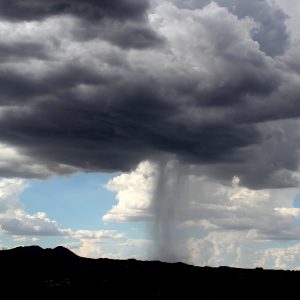 Using a combination of field instrumentation, unmanned aerial vehicles and a hydrologic model, a team of researchers from Arizona State University and the Jornada Long-Term Ecological Research Program of the National Science Foundation has been studying the fate of monsoon rainfall and its impact on groundwater recharge in the Chihuahuan Desert of New Mexico.
Their findings, recently published in the journal Water Resources Research, explain how a surprising amount of rainfall, nearly 25 percent, from monsoon storms is absorbed into small stream beds and percolates into the groundwater system. The researchers identified factors affecting the percolation process through the use of a numerical model that reproduced the long-term observations obtained at a highly instrumented research site.
“The results of this study show that monsoon storms serve an important role in recharging groundwater aquifers near the point of runoff generation,” said ASU hydrologist Enrique Vivoni of the School of Earth and Space Exploration and the School of Sustainable Engineering and the Built Environment. “This is an essential process that banks renewable surface water for future use as a groundwater resource in the arid Southwest and throughout the world.”
Using a combination of field instrumentation, unmanned aerial vehicles and a hydrologic model, a team of researchers from Arizona State University and the Jornada Long-Term Ecological Research Program of the National Science Foundation has been studying the fate of monsoon rainfall and its impact on groundwater recharge in the Chihuahuan Desert of New Mexico.
Their findings, recently published in the journal Water Resources Research, explain how a surprising amount of rainfall, nearly 25 percent, from monsoon storms is absorbed into small stream beds and percolates into the groundwater system. The researchers identified factors affecting the percolation process through the use of a numerical model that reproduced the long-term observations obtained at a highly instrumented research site.
“The results of this study show that monsoon storms serve an important role in recharging groundwater aquifers near the point of runoff generation,” said ASU hydrologist Enrique Vivoni of the School of Earth and Space Exploration and the School of Sustainable Engineering and the Built Environment. “This is an essential process that banks renewable surface water for future use as a groundwater resource in the arid Southwest and throughout the world.” Monsoon rains found to be beneficial to underground aquifers
 Using a combination of field instrumentation, unmanned aerial vehicles and a hydrologic model, a team of researchers from Arizona State University and the Jornada Long-Term Ecological Research Program of the National Science Foundation has been studying the fate of monsoon rainfall and its impact on groundwater recharge in the Chihuahuan Desert of New Mexico.
Their findings, recently published in the journal Water Resources Research, explain how a surprising amount of rainfall, nearly 25 percent, from monsoon storms is absorbed into small stream beds and percolates into the groundwater system. The researchers identified factors affecting the percolation process through the use of a numerical model that reproduced the long-term observations obtained at a highly instrumented research site.
“The results of this study show that monsoon storms serve an important role in recharging groundwater aquifers near the point of runoff generation,” said ASU hydrologist Enrique Vivoni of the School of Earth and Space Exploration and the School of Sustainable Engineering and the Built Environment. “This is an essential process that banks renewable surface water for future use as a groundwater resource in the arid Southwest and throughout the world.”
Using a combination of field instrumentation, unmanned aerial vehicles and a hydrologic model, a team of researchers from Arizona State University and the Jornada Long-Term Ecological Research Program of the National Science Foundation has been studying the fate of monsoon rainfall and its impact on groundwater recharge in the Chihuahuan Desert of New Mexico.
Their findings, recently published in the journal Water Resources Research, explain how a surprising amount of rainfall, nearly 25 percent, from monsoon storms is absorbed into small stream beds and percolates into the groundwater system. The researchers identified factors affecting the percolation process through the use of a numerical model that reproduced the long-term observations obtained at a highly instrumented research site.
“The results of this study show that monsoon storms serve an important role in recharging groundwater aquifers near the point of runoff generation,” said ASU hydrologist Enrique Vivoni of the School of Earth and Space Exploration and the School of Sustainable Engineering and the Built Environment. “This is an essential process that banks renewable surface water for future use as a groundwater resource in the arid Southwest and throughout the world.”